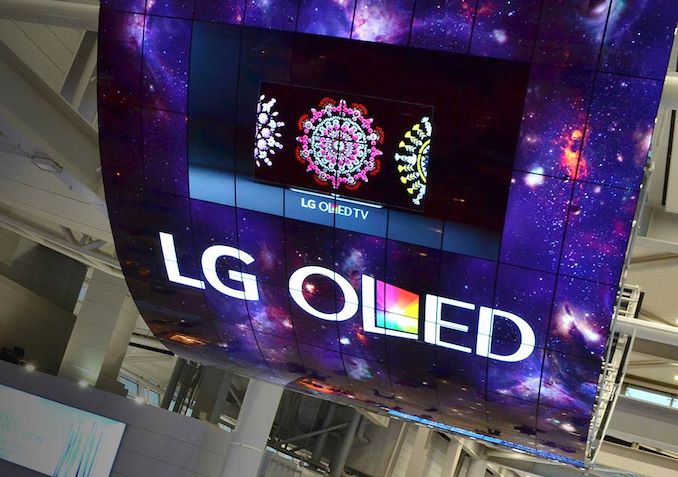LG to Start Production of OLEDs in China Next Month, Set to Double OLED Output
by Anton Shilov on July 11, 2019 4:00 PM EST- Posted in
- Monitors
- Displays
- LG
- OLED
- LG Display

LG Display this week said that its plant in Guangzhou, China, would start full swing operations next month. The factory, which cost LG around $4.2 billion, will produce large OLED panels for Ultra-HD televisions. The new manufacturing capacity will nearly double LG’s output of OLED substrates and will enable the company to cut its costs.
LGD’s new 8.5G (2200×2500) OLED factory in Guangzhou will produce 60,000 substrates for large TVs per month, which will almost double output of the company’s OLED substrates to 130,000 per month. Eventually, the plant will be expanded with the second line and will increase its capacity to 90,000 substrates per month.
One of the world’s largest makers of OLED panels first announced plans to build a plant in China in mid-2017. It took LG Display a year to obtain necessary permissions from the Chinese and South Korean governments and then a year to build the factory. This month the company starts trial production and next month mass production is set to commence
LG Display invested about $4.2 billion in its Guangzhou facility, but it hopes the expenses will pay off. Firstly, there are lower wages in China when compared to South Korea. Secondly, subsidies from the Chinese government will enable LG to cut its depreciation costs by 65%. Thirdly, the new fab could allow LG to offset possible disruption of OLED production in South Korea because of the ongoing diplomatic conflict between Japan and South Korea. Fourthly, it will make LG Display more competitive against companies like BOE in the Chinese market.
Increased output and lower production costs will allow LG to make its OLED panels and therefore OLED TVs cheaper. Still, the exact effect is something that remains to be seen.
Related Reading:
- Supply of DRAM, NAND & Displays Could Be Disrupted by Japan & South Korea Dispute
- LG To Close Korean Phone Manufacturing Plants - Relying On Cheaper Overseas Factories
- LG Announces The New G8 & V50 5G ThinQ
- CES 2019: LG Announces Signature OLED TV R - A Rollable TV
Sources: The Investor, OLED Info










37 Comments
View All Comments
lilkwarrior - Saturday, July 13, 2019 - link
It's going to be interesting when they release their 4K@120hz OLED monitor in Q4. I'm ordering one immediately without a doubt!FreckledTrout - Friday, July 12, 2019 - link
Dell actually did make an OLED monitor but it was expensive and nobody bought it. When the costs come down we will see OLED monitors.lilkwarrior - Saturday, July 13, 2019 - link
Actually Dell did, but that monitor was short-lived due to how prohibit it was to manufacture at large-scale among other reasons. They are releasing the 55inch OLED 4K@120hz full HDMI 2.1 monitor (w/ HDR + VRR) w/ G-Sync & Dolby Vision likely using their Alienware white label. That monitor on release in Q4 will be the best gaming monitor ever.They were smart to wait for HDMI 2.1 + Displayport to maximize doing the QA overhead & etc to have a 4K@120hz 0.1ms monitor.
Lolimaster - Friday, July 12, 2019 - link
Given the technology, you should wait for microLED monitors and before that VA monitors with miniLED backlight so you can have 2000-5000 zones.Hisense approach with a polarized LCD layer to their panels acting as a dimming zone seems the cheapest way for "inky blacks".
FreckledTrout - Friday, July 12, 2019 - link
MiniLED with the 1000+ backlight zones should be pretty damn good if paired with a high quality panel..longhill - Friday, July 12, 2019 - link
I'd rather have a 36-38" 4k OLED monitor. 32" is too small for running at native resolution.chuyayala - Friday, July 12, 2019 - link
This would definitely be the sweet spotAlistair - Friday, July 12, 2019 - link
you don't need to worry about native resolution honestly, it only affects windows, not scalable programs...mooninite - Thursday, July 11, 2019 - link
Nice, but color fade will always be a problem. A.K.A. "burn-in"Bring on the Micro-LED sets...
imaheadcase - Friday, July 12, 2019 - link
Except that is not really a thing for normal users. It only became a "issue" when business or company ran the same channel or display 24/7. I only buy OLED TV and never a issue myself.